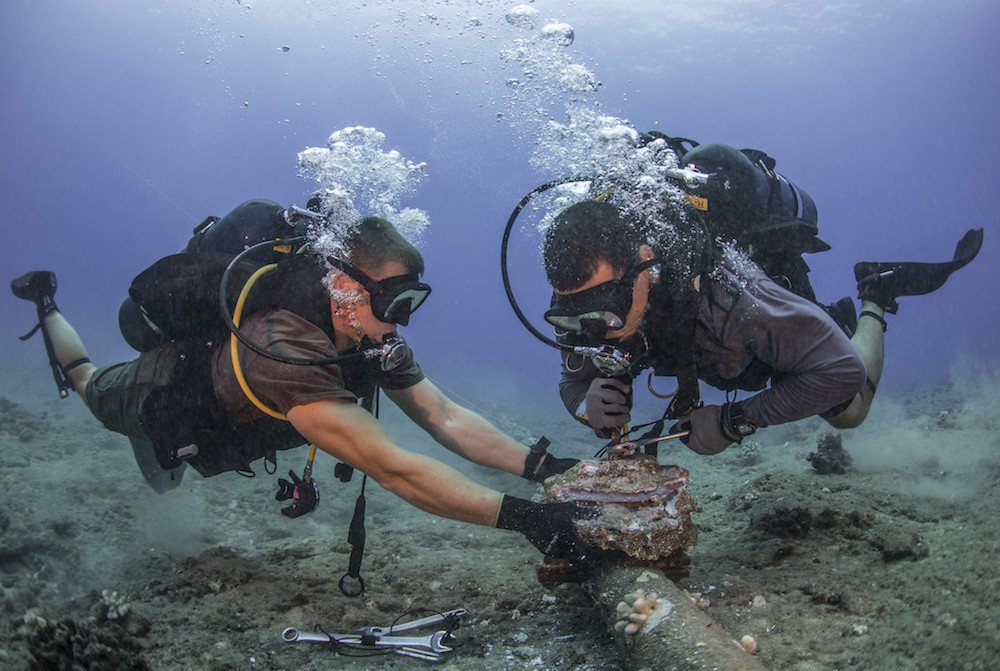
[Image above] United States Navy personnel remove corroded zinc anodes from an undersea cable. Could undersea cables offer a way to monitor underwater seismic quakes closer to the source? Credit: Official U.S. Navy Page, Flickr (CC BY 2.0)
Lawrence Berkeley National Laboratory researchers are at it again—and this time, they took their dark fiber research to an even darker place.
Dark fiber refers to fiber-optic cables that were installed but currently lay unused. Thousands of miles of dark fiber crisscross the United States underground.
In February, we reported on experiments conducted by Berkeley Lab researchers led by Jonathon Ajo-Franklin on using dark fibers to detect earthquakes on land. Specifically, they investigated using dark fibers for distributed acoustic sensing (DAS), a sensing system that measures strain by relying on fiber-optic cables’ high sensitivity to deformations.
They used a 27-km (17-mi) segment of the 13,000-mi-long dark fiber testbed owned by DOE Energy Sciences Network (ESnet) for their tests. The results were promising. “The coverage of the ESnet Dark Fiber Testbed provided us with subsurface images at a higher resolution and larger scale than would have been possible with a traditional sensor network,” co-author Verónica Rodríguez Tribaldos, a postdoctoral researcher in Ajo-Franklin’s lab, said in a Berkeley Lab news release at the time.
However, monitoring seismic quakes on land is only part of constructing a robust seismographic network. “One of the blank spots in the seismographic network worldwide is in the oceans,” Ajo-Franklin says in a recent University of California, Berkeley press release.
Marine waters cover more than 70% of the Earth’s surface, and some of the largest tsunamis are caused by subduction of tectonic plates far away from land. In some cases, land-based seismometers monitoring these regions are more than 100 miles away, hindering prediction speed and accuracy, according to Columbia University professor Spahr Webb in an article in The Atlantic.
Monitoring seismic quakes caused by plate tectonics closer to the source would greatly improve tsunami prediction. But “it is challenging to put instruments like seismometers at the bottom of the sea,” UC Berkeley professor Michael Manga says in the press release. Fortunately, just as fiber-optic cables detect seismic waves on land, fiber-optic cables could be used for DAS underwater as well.
The subsea fiber-optic cable network is expansive, as seen in the submarine cable map by telecommunications market research company TeleGeography. Ajo-Franklin (now a professor at Rice University) and his colleagues Nathaniel Lindsey (graduate student under Manga, UC Berkeley) and T. Craig Dawe (technical support manager, Monterey Bay Aquarium Research Institute) used a portion of this underwater network in their recent study.

Ajo-Franklin, Lindsey, and Dawe used 20 km (pink) of a 52-km undersea fiber-optic cable as a seismic array to study fault zones under Monterey Bay. During the four-day test, they detected a magnitude 3.4 earthquake and mapped previously uncharted fault zones (yellow circle). Credit: Nathaniel Lindsey, Lawrence Berkeley National Laboratory
The researchers employed 20 km (12.4 mi) of a 52-km undersea fiber-optic cable as a seismic array to study the fault zones under Monterey Bay. The cable normally supports the Monterey Accelerated Research System, but it was off during a four-day maintenance period in March 2018.
As explained in the press release, the researchers “were able to measure a broad range of frequencies of seismic waves from a magnitude 3.4 earthquake that occurred 45 kilometers inland near Gilroy, California, and map multiple known and previously unmapped submarine fault zones, part of the San Gregorio Fault system.” They also detected steady-state ocean waves and storm waves, and their measurements matched those gathered by buoy and land seismic monitors.
“This research shows the promise of using existing fiber-optic cables as arrays of sensors to image in new ways,” Manga says.
While using dark fibers for seismic monitoring holds a lot of potential, Ajo-Franklin and Lindsey hope to take the research a step further—by using lit fiber-optic cables for seismography.
Lit fiber-optic cables refer to fiber-optic cables actively being used for data transmission. To use lit fiber-optic cables for seismic monitoring, laser pulses need to be able to travel through one channel in the fiber without interfering with other channels carrying independent data packets.
Ajo-Franklin and Lindsey are conducting experiments now with lit fibers, and they also plan to conduct fiber-optic monitoring of seismic events in a geothermal area south of Southern California’s Salton Sea, in the Brawley seismic zone.

An undersea internet cable consists of numerous optical fibers wrapped inside copper, plastic, and steel. Lit fiber-optic cables could potentially use one fiber for DAS while the others transmit data. Credit: Earth Titan, YouTube
The paper, published in Science, is “Illuminating seafloor faults and ocean dynamics with dark fiber distributed acoustic sensing” (DOI: 10.1126/science.aay5881).
Author
Lisa McDonald
CTT Categories
- Environment
- Material Innovations
- Optics


